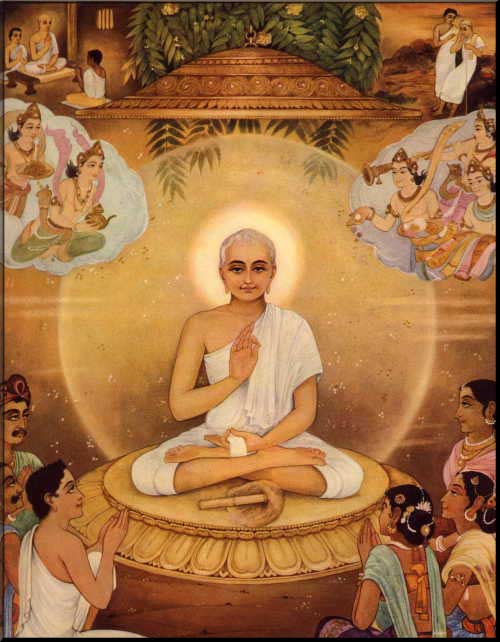A Story of Ganadhar Sudharma Swami
Ganadhars (or Ganadhara) are the immediate disciples of a Tirthankar. Bhagawan Mahavir had eleven Ganadhars. All of Bhagawan Mahavir’s monks were divided into 11 groups and each group was placed under a Ganadhar. When Bhagawan Mahavir attained Nirvana, only two of the eleven Ganadhars were still living, the first Ganadhar, Gautam-swami and the fifth Ganadhar, Sudharma-swami.
Gautam-swami attained Keval-jnan the day after Mahavir’s Nirvana. It is a Jain tradition that a Kevali monk or nun remains in a meditative state for the rest of his/her life and does not provide a leadership role to other monks. Hence, Sudharma-swami became the leader of all of the ascetics and the entire Jain community after Lord Mahavir’s Nirvana.
Sudharma-swami was the son of a learned Brahmin named Dhammil and his wife Bhaddila. They lived in a village called Kollag, now known as Kollua in the state of Bihar, India. Dhammil and Bhaddila both longed for a child. Bhaddila worshipped goddess Saraswati (goddess of knowledge) faithfully. It is said that the goddess, pleased by her devotion, blessed Bhaddila by promising her a highly accomplished son. Soon after that, Bhaddila became pregnant, and in due course gave birth to a son named Sudharma. He was born in 607 BC, and was 8 years older than Lord Mahavir.
Sudharma grew up under the loving care of his parents. At an appropriate age, he went to a well-known Ashram (boarding school), where he studied the Vedas, Upanishads, and all other Hindu (Brahmanical) literature. He was a diligent scholar. By the time he returned from school, he was famous and well respected as a learned Brahmin Pundit. He then started his own school, which became a center of great learning. Over 500 pupils from all over the country came to study under his tutelage.
At that time in Pavapuri (also known as Apapa), a city in Bihar, there lived a prosperous Brahmin named Somil. He had organized a great sacrificial Yajna. He invited all the well-known scholars of the time to the event. Indrabhuti Gautam, who was the most learned Brahmin of that time, was the presiding priest. His equally learned brothers, Agnibhuti and Vayubhuti, attended along with seven other well-known Pundits. Sudharma was also invited.

A preaching Ganadhar, surrounded by lay community and celestiel beings (Vidhydharas) above
At the appointed time, the sacrificial ceremony began. At that time, the attendees noticed many celestial chariots descending towards the earth. Indrabhuti and the other priests were jubilant that they could persuade the celestial beings to descend and accept their respects. However, they were soon disappointed to see that the chariots passed over their ceremonial site and continued towards the nearby Mahasen forest. The celestial beings had actually come to pay their respects to Bhagawan Mahavir who had arrived at Pavapuri at the same time. After attaining Keval-jnan, Bhagawan Mahavir was going to deliver his first sermon and establish the Jain order.
Indrabhuti was outraged that the celestial beings did not pay their respect to his sacrificial rite. He decided to debate with Mahavir in order to prove to the celestial beings that he was more knowledgeable than Mahavir. So he left with his 500 followers to debate with Mahavir. He went to the place where Lord Mahavir was giving the sermon. As he approached, the Lord welcomed him saying, “Welcome Indrabhuti Gautam.” Indrabhuti was surprised. Then Bhagawan Mahavir addressed his doubts pertaining to the existence of the soul. After the explanation Indrabhuti and his 500 followers became the disciples of Mahavir.
Since Indrabhuti did not come back, his brothers Agnibhuti, Vayubhuti, and another Pundit, Vyakta, went to Bhagawan Mahavir one after another. Bhagawan Mahavir welcomed them, and addressed their doubts pertaining to different aspects of the soul and Karma. All of them were satisfied with Lord Mahavir’s knowledge and they, along with their own disciples, became disciples of Lord Mahavir. Then it was Sudharma’s turn. Sudharma believed that every living being would reincarnate into its own species. In other words, human beings would be reborn only as human beings. His theory was based on the analogy of plant life. An apple tree, for instance, would produce the seeds from which only other apple trees could grow.
Bhagawan Mahavir welcomed him too. He calmly and patiently explained to Sudharma that human beings could be reincarnated as humans or heavenly beings or even as animals depending upon their Karma. He addressed all of Sudharma’s doubts and explained to him the theory of Karma. Sudharma saw the wisdom of Bhagawan Mahavir’s words and was convinced with the explanation and he too became a disciple of Bhagawan Mahavir. As a Ganadhar of Bhagawan Mahavir, he came to be known as Sudharma-swami. Sudharma brought with him his five hundred disciples. He was then followed by the remaining six Brahmin scholars. All eleven pundits became the Ganadhars of Bhagawan Mahavir. Dejected and abandoned, Somil cancelled the sacrificial ceremony and set all the animals free. This happened when Mahavir was 42 years old and had just attained omniscience. Mahavir lived for another 30 years.
During that period he continued to travel to different parts of the country in order to spread the message of compassion and explain the path of liberation. During those discourses, Sudharma swami always sa
Jainism has deep roots and we practice it based on the scriptures that have passed down for many generations. The scriptures called Agams, compiled by the Ganadhars, comprise of the preachings of Mahavir-swami. We do not have the benefit of the presence of such great monks as Gautam-swami and Sudharma-swami in this era, but we do have the benefit of learning those principles from the scriptures. Thus, we should take advantage of the scriptures that have passed down through many generations.